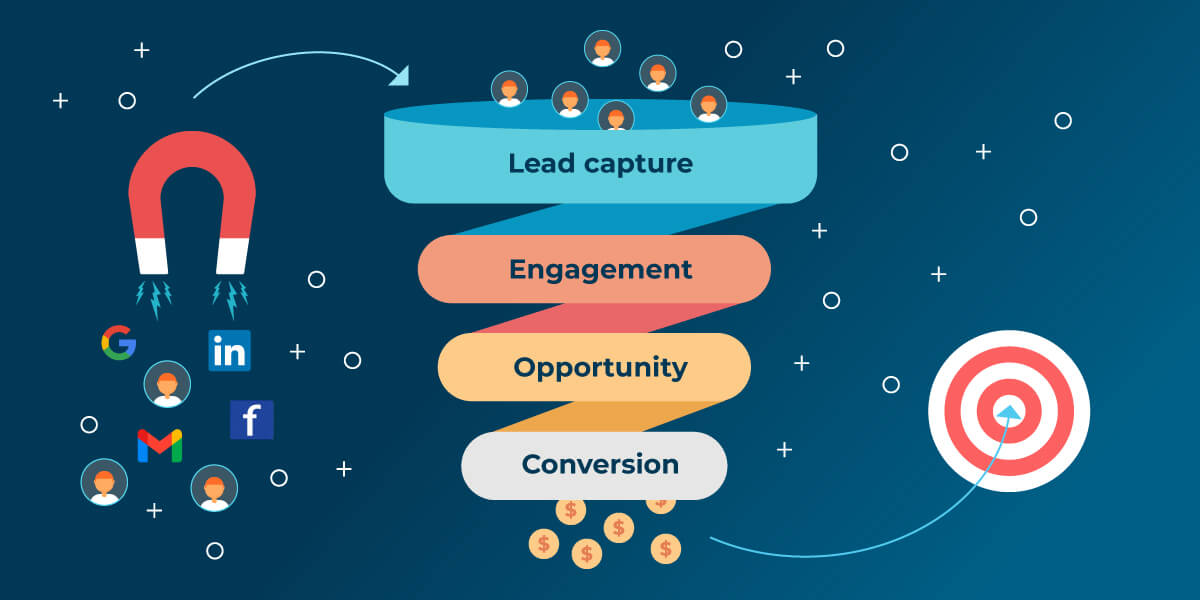Lead management is the foundation of a successful sales process. It involves gathering qualified leads that align with your target personas and guiding them through the lead lifecycle as efficiently as possible. This ongoing process requires prompt follow-up with leads, proper segmentation, and assignment to the right sales reps while maintaining appropriate follow-up intervals.
Effective lead management ensures that your leads receive relevant information that increases the likelihood of converting them into customers. This approach benefits both parties: your leads won’t be bothered by irrelevant marketing content, and you’ll save time and resources by focusing on targeted marketing, ultimately boosting profits. When combined with automation, lead management can become a largely self-sufficient relationship-building machine.
6 stages of the lead management process “Lead management” is a broad term that encompasses numerous steps and strategies (similar to the term “marketing”). To help you navigate this process effectively, here is a step-by-step guide:
-
Lead generation
Before driving qualified leads down the lead generation funnel, you first need to collect their information. Lead generation is about offering the right “entry points” for potential customers. Your company website is an obvious place to gather leads through newsletter sign-ups, product demo CTAs, and gated content that provides value to your target audience. Social media, email marketing tactics, and other lead generation tools can also be employed to collect audience information.
Essential information includes email addresses, names, and industry/role, with phone numbers being optional based on your business operations. Plan how to organize this information in your CRM to align with your existing marketing strategy.
-
Lead qualification and segmentation
Not all collected leads will be worth pursuing actively. Some leads may join your lists out of curiosity but may not match your desired customer profile or have genuine interest in your product. To avoid wasting your sales team’s time, vet leads first.
Lead qualification is about dedicating time and effort to the right leads, specifically those members of your target audience who are ready to purchase your product or service. If you don’t have a lead qualification process in place, it’s crucial to invest resources in developing one.
For instance, you can require leads to describe their role and their organization’s needs when signing up for a newsletter or downloading gated content. If this information doesn’t match your target customer, segment them into an “unqualified leads” group or a more specific category for potential targeting later.
-
Lead nurturing
Most leads are not ready to buy upon their first interaction with your brand. To guide them through their customer journey, you need to nurture them. Lead nurturing allows you to stay in touch with potential buyers until they’re ready to buy.
Providing leads with relevant content helps them better understand your brand, feel recognized, and learn how you can assist them. This builds trust and keeps you top of mind when they’re prepared to make a purchase.
The content used to nurture leads will depend on your audience, but it generally includes:
- Blog articles
- Email campaigns
- Customer success stories
- White papers
- eBooks
- Infographics
While the marketing team will create this content, the sales team can provide feedback on its effectiveness and the types of questions potential customers are asking. Sales reps can also help marketers identify content gaps that need filling to assist buyers in their decision-making process.
Remember: Lead nurturing begins the moment someone interacts with your brand and continues throughout the buying process, even after they’ve become customers.
-
Lead scoring
Lead scoring is the process of identifying sales-ready leads so you know when to pass them on to the sales team. Using the insights you’ve gathered, score leads against the description of a sales-ready lead created during the lead qualification process.
Lead scores are a numerical (or at least less subjective) representation of a lead’s interest in your business, their current stage in the buying process, and how well they match your ideal customer profile.
Your CRM software should handle most of the lead scoring work for you. With automated lead scoring, the timing will always be right, and as you know, timing can be the difference between winning or missing out on sales.
Here’s the general process:
- You assign point values to specific demographic information and various activities, such as event attendance, visits to certain web pages, content downloads, and form submissions, within your CRM.
- As leads enter the CRM during lead generation, the CRM automatically scores them based on your criteria.
- When a designated score is reached, your CRM notifies the sales team to further qualify and advance through the sales process.
Getting this right means not wasting time on unqualified leads, which, in turn, gives sales reps more time to speak with prospects who are ready—at the exact moment they’re ready.
Initially, it’s best to err on the side of caution and hand leads over to sales earlier. If necessary, have them passed back for more lead nurturing until they’re ready. Based on this kind of feedback, you can adjust your lead scoring over time.
-
Lead distribution
Once leads have passed through the lead scoring process, they need to be sent to the sales rep best equipped to help them. Factors to consider include:
- Geographic location (aligned with the prospect)
- Seniority
- Experience selling to a specific industry or customer type
- Performance
- Availability to respond to the lead fastest
Not all of these factors apply to every business. The elements you prioritize will depend on your industry, what you’re selling, and various other factors.
In some cases, you might send leads to reps in consecutive order or even allow reps to select leads from a pool. However, having sales leadership involved in these decisions is important—they know which reps will be able to best help the people who are ready for them.
Just like with lead scoring, once you define criteria in your CRM or marketing and sales automation tool, like Smarketing Cloud, it’ll handle distribution for you.
-
Tracking and adjusting
Lead management is an iterative process. You need to track which leads become paying customers, what worked, what didn’t work, and where improvements can be made. You’ll be looking at metrics like the length of a sales cycle after a lead is handed off and the percentage of leads closed by sales reps. Combined with feedback from the sales team, you’ll be able to tweak your lead management processes over time.
Again, all tracking will be automated in your CRM. Most CRMs offer one-click reports to give you information on your primary metrics, or you can set up more complex reports to track the metrics that are most important to you.
Best practices for lead management The lead management process is easier said than done. To help you succeed, here are some proven tips:
- Automate inbound lead qualification using your CRM and tools like Smarketing Cloud to identify sales-qualified leads (SQLs) and segment them for quick handoff to your sales team.
- Don’t leave your SQLs waiting. Respond to their inquiries or expressions of interest as soon as possible to maintain momentum and drive them through the lead lifecycle.
- Reduce time to value by providing useful top-funnel sales enablement content that demonstrates your offerings and incentivizes lead generation through gated content, newsletter sign-up forms, and other strategies.
- Play the long game. Invest time and energy into all leads, as some may simply be on a longer sales cycle than others, and investing in them could pay off big in the long run.
- Never stop nurturing. Support your account managers by identifying ways to expand deals or re-engage leads that have gone cold, regardless of whether your sales team closed the deal.
- Measure your efforts. Some lead generation campaigns will inevitably be more successful than others. Actively monitor how well your campaigns perform to make wiser decisions about resource allocation.
Leveraging technology for effective lead management Effective lead management can make or break your sales process. To help you succeed, it’s essential to leverage the right technology. Smarketing Cloud is a powerful marketing and sales automation tool that can help you automate and streamline your lead management process.
Here’s how Smarketing Cloud can support your lead management efforts:
- Centralize data: Smarketing Cloud can serve as a central hub for all your lead data, making it easy for your sales and marketing teams to access and use the information they need.
- Automate processes: With its robust automation features, Smarketing Cloud can help you automate various aspects of your lead management process, including lead qualification, lead scoring, and lead distribution.
- Enhance communication: Smarketing Cloud allows you to create and manage personalized email campaigns and other communication strategies to nurture leads and keep them engaged throughout their buyer journey.
- Monitor performance: Smarketing Cloud’s built-in analytics and reporting features provide you with insights into the effectiveness of your lead management strategies, helping you make data-driven decisions to improve your results.
- Integration with CRM: Smarketing Cloud can integrate seamlessly with your CRM system, ensuring that your sales and marketing teams have access to the most up-to-date information about your leads.
In conclusion, effective lead management is crucial to the success of your sales process. By following the six stages of lead management and implementing best practices, you can ensure that your leads receive the right information and attention, driving them through the lead lifecycle as efficiently as possible.
With the help of powerful marketing and sales automation tools like Smarketing Cloud, you can streamline your lead management process, save time and resources, and ultimately increase your sales and profits.











